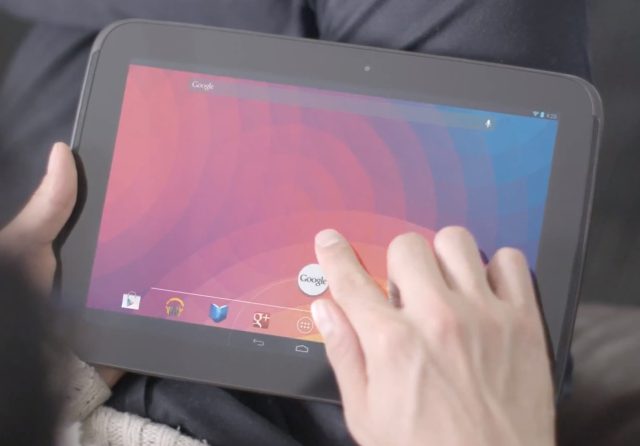
The Android news keeps coming in spite of Google's cancelled Android event—the company has just taken the wraps off of the Nexus 10 tablet, the 10-inch follow-up to the well-reviewed Nexus 7 tablet introduced in June. Unlike its ASUS-made cousin, the new Nexus 10 was manufactured by Samsung with Google's input, and will be available for $399 (16GB) and $499 (32GB) when it goes up for sale on November 13.
The tech in the new tablet is definitely top-shelf material: it features one of Samsung's new Cortex A15-based Exynos 5 chips clocked at 1.7 GHz, and its quad-core Mali-T604 GPU helps to drive a 10.055-inch PLS display with a resolution of 2560x1600. This 300 pixel-per-inch screen has four times the number of pixels in a 1280x800 screen and edges out the Retina iPad's 264 pixels per inch. The tablet's CPU should compare favorably to the Apple-designed CPU cores in its A6 and A6X processors, and the GPU should at least be playing in the same field as the A5X and A6X—we won't know for sure how they all shake out until we actually have hardware in-hand to test with.
Other specs common to high-end Android tablets are also present: 2GB of RAM, storage capacities starting at 16GB, NFC, 802.11n, and Bluetooth 4.0. There are front and rear-facing cameras (at 1.9 and 5 megapixels, respectively). It also has a 9,000mAh battery that Google says is good for nine hours of use. Like the Nexus 7, it lacks a microSD card slot, so the amount of storage you buy with it is the amount that it's stuck with—it does have micro USB and micro HDMI ports, however. It's also running the enhanced version of Jelly Bean, Android 4.2, and as part of the Nexus program should get prompt operating system updates for the foreseeable future.
This tablet is the first-ever 10-inch tablet to bear the Nexus branding, but it's not the first 10-inch tablet to run stock Android and get prompt updates: the honor belongs to the Motorola Xoom, which Google and Motorola released to showcase Honeycomb in early 2011. We had mixed feelings about the Xoom in our original review, but we were more impressed when we re-reviewed it after its Jelly Bean update rolled out—we called it "the right software in search of the right hardware," and as long as it doesn't inherit the chintzy, flexible plastic of Samsung's Galaxy Note 10.1, the Nexus 10 might just be that hardware.
Update: the original version of this article said that the Nexus 10 had a Super AMOLED display; it actually uses a plane-to-line switching (PLS) display.
reader comments
131